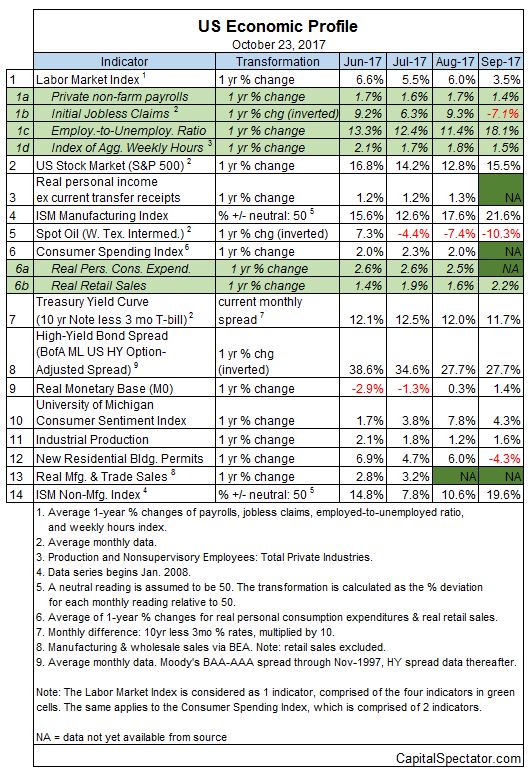US economic activity has slowed recently, but the downshift still leaves the economic trend humming at a respectable pace, based on a broad set of indicators published to date.
Blowback from the recent hurricanes continue to weigh on the numbers, according to analysts. “Hurricanes Harvey and Irma have distorted many of the economic data releases, but the impacts are transitory and should unwind without any significant effect on the underlying trends,” advises Scott Brown, chief economist at Raymond James, in a research note this week.
The headwinds are expected to trim this Friday’s preliminary estimate of third-quarter GDP growth to 2.8%, based on the median forecast via CNBC’s survey of Wall Street analysts (as of Oct. 20). That’s down from Q2’s solid 3.1% advance, but only slightly.
Meantime, the latest estimate of recession risk for the US remains low, based on The Capital Spectator’s business-cycle benchmarks, which reflect a diversified set of economic datasets. Most of the underlying indicators for Sep. have been published and the majority continue to reflect a positive trend. (For a more comprehensive review of the macro trend on a weekly basis, see The US Business Cycle Risk Report.)

Aggregating the data in the table above continues to translate into a positive bias overall. The Economic Trend and Momentum indices (ETI and EMI, respectively) remain well above their respective danger zones (50% for ETI and 0% for EMI). When/if the indexes slide below those tipping points, the declines will mark clear warning signs that recession risk is elevated and a new downturn is likely. The analysis is based on a methodology that’s profiled in my book on analyzing the business cycle.

Translating ETI’s historical values into recession-risk probabilities via a probit model also points to low business-cycle risk for the US through last month.Studying the data in this framework indicates that the odds remain close to zero that NBER will declare September as the start of a new recession.












Leave A Comment